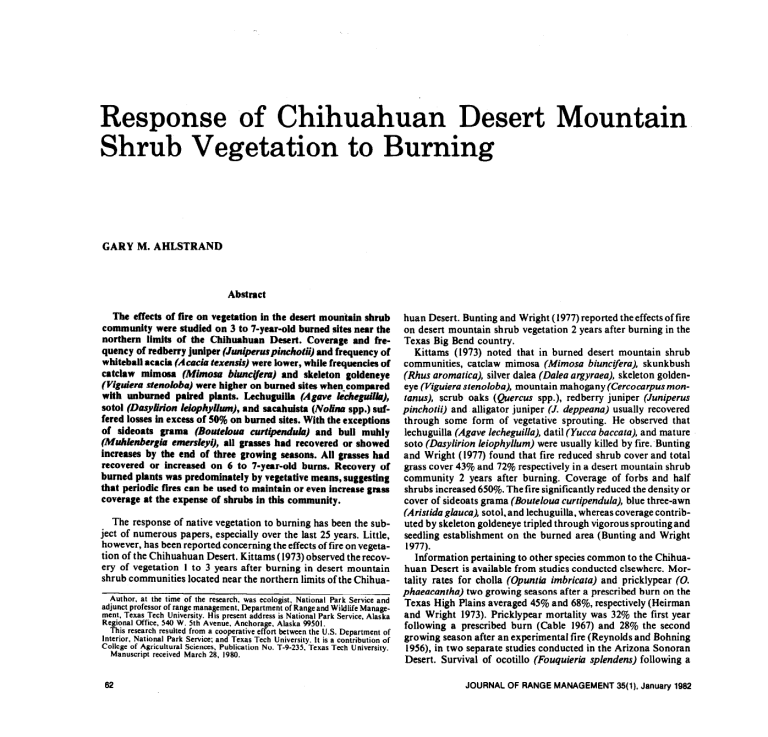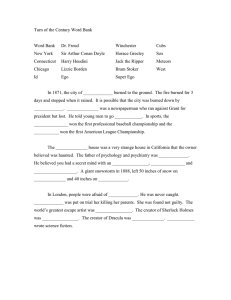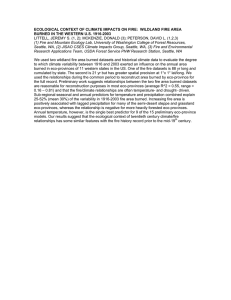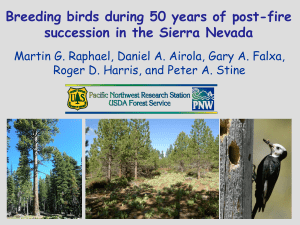this PDF file - Journals at the University of Arizona
advertisement

Response of Chihuahuan Desert Mountain Shrub Vegetation to Burning GARY M. AHLSTRAND Abstract The effects of fire on vegetation in the desert mountain shrub community were studied on 3 to 7-year-old burned sites near the northern limits of the Chihuahurn Desert. Coverage and frequency of redberry juniper (Juniipcruspinchotii) and frequency of whitebail acacia (Acacia texends) were lower, while frequencies of catclaw mimosa (Mimosa biunc~em) and skeleton goldeneye (Viguiera stenoloba) were higher on burned sites when_compared with unburned paired piants. Lechuguiiia (Agave lecheguil&, sotoi (DasytYrion leiophylbun), and sacahuista (No&r spp.) suffered losses in excess of 50% on burned sites. With the exceptions of sideoats grama (Bouteloua curtipendula) and bull muhiy (Muhlenbergia emersleyi), ail grasses had recovered or showed increases by the end of three growing seasons. Ail grasses had recovered or increased on 6 to 7-year-old bums. Recovery of burned piants was predominately by vegetative means, suggesting that periodic fires can be used to maintain or even increase grass coverage at the expense of shrubs in this community. The response of native vegetation to burning has been the subject of numerous papers, especially over the last 25 years. Little, however, has been reported concerning the effects of fire on vegetation of the Chihuahuan Desert. Kittams (1973) observed the recovery of vegetation I to 3 years after burning in desert mountain shrub communities located near the northern limits of the ChihuaAuthor. at the time of the research. was ecologist. National Park Service and adjunct professor of range management. Department of Rangeand Wildlife Management. Texas Tech University. His present address is National Park Service, Alaska Regtonal Office, 549 W. 5th Avenue, Anchorage, Alaska 99501. This research resulted from a cooperative effort between the U.S. Department of Interior, National Park Service; and Texas Tech University. It is a contribution of College of Agricultural Sciences, Publication No. T-9-235. Texas Tech University. Manuscript received March 28, 1980. 62 huan Desert. Bunting and Wright (1977) reported theeffectsof fire on desert mountain shrub vegetation 2 years after burning in the Texas Big Bend country. Kittams (1973) noted that in burned desert mountain shrub communities, catclaw mimosa (Mimosa biuncifera). skunkbush (Rhus aromatica), silver dalea (Dalea argyraea), skeleton goldeneye (Viguiera stenoloba). mountain mahogany (Cercocarpus montanus), scrub oaks (Quercus spp.), redberry juniper (Juniperus pinchotii) and alligator juniper (J. deppeana) usually recovered through some form of vegetative sprouting. He observed that lechuguilla (Agave lecheguilla), datil (Yucca baccata), and mature soto (Dasylirion leiophyllum) were usually killed by fire. ,Bunting and Wright (1977) found that fire reduced shrub cover and total grass cover 43% and 72% respectively in a desert mountain shrub community 2 years after burning. Coverage of forbs and half shrubs increased 650%. The fire significantly reduced the density or cover of sideoats grama (Bouteloua curtipendula), blue three-awn (Aristida glauca), sotol, and lechuguilla, whereas coverage contributed by skeleton goldeneye tripled through vigorous sprouting and seedling establishment on the burned area (Bunting and Wright 1977). Information pertaining to other species common to the Chihuahuan Desert is available from studies conducted elsewhere. Mortality rates for cholla (Opuntia imbricata) and pricklypear (0. phaeacantha) two growing seasons after a prescribed burn on the Texas High Plains averaged 45% and 68%, respectively (Heirman and Wright 1973). Pricklypear mortality was 3270 the first year following a prescribed burn (Cable 1967) and 28% the second growing season after an experimental tire (Reynolds and Bohning 1956), in two separate studies conducted in the Arizona Sonoran Desert. Survival of ocotillo (Fouquieria splendens) following a JOURNAL OF RANGE MANAGEMENT 35(l). January 1999 wildfire in the Sonoran Desert was 33Ycfor heavily damaged plants and 50% for plants only scorched (White 1969). Regeneration occurred primarily through basal sprouting. Algerita (Berberis trifoliolata) sprouted vigorously following a wildfire in south central New Mexico (Dwyer and Pieper 1967). The objective of this study was to document longer term effects of fire on vegetation in the mountain shrub community of the Chihuahuan Desert by examining 3 to ‘I-year-old burned areas. compared between burned and unburned sites using analysis of variance and Chi-square analyses, respectively. Student’s t-test was used to determine differences in coverage by growth forms on burned and unburned sites. Differences were judged to be significant at the 0.05 level. Taxonomic nomenclature follows Correll and Johnston (1970). Results and Discussion Of the 95 species sampled in the 7 paired sites, 47 were common Study Area to 2 or more of the paired sites. Because drought conditions prevailed throughout the sampling period, few annuals were presThe study sites are in the Guadalupe Mountains of Eddy ent and perennial forbs were not abundant. Most grasses were County, New Mexico, and Culberson County, Texas. The mounidentified using vegetative characteristics. tains, primarily limestone, are part of a Permian reef complex Coverage and frequency of redberry juniper were less on burned termed the Capitan Barrier Reef. The area’s semiarid, continental than on unburned sites. Kittams (1973) observed that a consideraclimate is characterized by mild winters, warm summers, and ble amount of heat is required to ignite this species, but once summer showers. The mean annual temperature is 19”C (63” F) at ignited it burns so vigorously that usually all the branches are 1,352 m (4,435 ft) in this community at Carlsbad Caverns National killed. Regeneration occurs slowly through crown sprouts. Burned Park, and annual frost-free days average 226 (U.S. Department of junipers in the present study regained up to 50% of their mature Commerce 1967). Mean annual precipitation is 36.6 cm (14.4. in), height during the 3- to 7-year recovery period, and the 25 to 50 but has ranged from less than 12 cm (4.6 in) to 110 cm (43.2 in)per years predicted by Kittams (1973) for top-killed plants to reyear. Nearly 90% of the annual precipitation occurs between May establish their prebum stature is a reasonable estimate. and October. The frequency of whiteball acacia (Acacia texensis) was greater Characteristic desert mountain shrub vegetation in the Guadaon unburned than on burned sites. Although this dwarf acacia is set lupe Mountains includes lechuguilla, sotol, and redberry juniper. back by fire, this effect may be only temporary until new colonies Prickly pear and sacahuista (Nolina spp.) are generally abundant, can form from rhizomes. and grama and three-awn grasses are common in the community. Burning induces vigorous crown sprouting in catclaw mimosa Vegetation of the area has been described by Gehlbach (1967), (Cable 1975, Carmichael et al. 1978). It may recover from burning Bunting (1978), and Northington and Burgess (1979). in as little time as 5 years (Kittams 1973). Although catclaw mimosa was not abundant on any of the sites in this study, its Methods frequency was greater on burned than on unburned sites. Skeleton goldeneye was more frequent on burned than on Seven sites that burned between 1967 and 1971 in the desert unburned sites. Kittams (1973) predicted this species would mountain shrub community of the Guadalupe Mountains were increase through root and crown sprouts 2 to 3 yearsafter burning. sampled during the summer of 1974. A similar unburned site was An increase was evident on 3-year-old bums and it persisted located near each burned site for comparison. Shrub intercepts through to ‘I-year-old burned sites. were measured by species along ten 25-m (82 ft) lines placed at 5-m (16.4 ft) intervals in each pair of sites. Fifty 20 X 50-cm (7.9 X 19.7 Coverage and frequency of sotol were 75% less on burned than on unburned sites. The sheath of dead leaves surrounding the trunk in) plots were sampled at 5-m (16.4 ft) intervals along each intercept line using a frame. Species included within or overlapping the makes this species especially susceptible to fire, and plants with plot frame were recorded according to one of six cover classes with fire-girdled trunks usually die. Sprouting occurs only from the midpoint cover percentages of 2.5, 15.0, 37.5,62.5, 85.0, and 97.5 terminal bud in lightly to moderately burned plants (White 1969, (Daubenmire 1968). Coverage was calculated for individual spe- Kittams 1973). The present study as well as that of Kittams (1973) cies from intercept and plot data, and frequency was determined found that surviving sotol regain most of their cover within 3 years, for species sampled with the plot frame. Sampling adequacy was but many more years will be required for plants to accumulate determined by a species area curve and by plotting cumulative shaggy bases of dead leaves. mean coverage (Mueller-Dombois and Ellenberg 1974). Sacahuista was less frequent on burned sites than on unburned. Burned sites were located using fire narrative records for CarlsSprouting occurred from the outer portion of the caudex in most bad Caverns and Guadalupe Mountains National Parks. No inforplants that survived burning. Kittams (1973) measured a 48% loss mation concerning fire intensity, defined as the product of fuel of sacahuista on a 197 I burn. This burn was studied 3 years later, as energy consumed and rate of fire spread (van Wagtendonk 1974), a part of the present study. Frequency and coverage for sacahuista was available, but fuels were estimated not to exceed 1.1 X 10s on the burned site were 53% and 47% respectively, of those present kg/ha (0.5 ton/acre) for litter and cured grasses and 1.6 X 104 on the unburned partner site. kg/ ha (7 tons/acre) for living vegetation. Annual precipitation was The frequency of lechuguilla was reduced on burned sites,and its near normal for the period since the fires, except for the year average coverage on burned sites was 19% of that on unburned preceding the sampling period, when drought conditions sites. The plant usually dies if more than half of its green leaves are prevailed. scorched (Kittams 1973). Surviving plants recover slowly from Except for two paired sites, all sampling was conducted within burning. A few rhizomatous offshoots were observed in the area of the boundaries of either C’arlsbad Caverns or Guadalupe Mountop-killed lechuguilla on a site burned 3 years previously. Fires of tains National Parks on sites that had been protected from live- the intensity usually experienced in this area are effective in reducstock grazing. The seven paired sites ranged in elevation from 1,490 ing lechuguilla. m (4,900 ft) to 1,770 m (5,800 ft) on 5 to 55% slopes with mixed Although prickly pear was not abundant on any of the sites, this aspects. Four of the fires were lightningcaused and occurred species was susceptible to fire on most of the study sites. Usually during June; one each in 1967 and 1968, and two in 1971. Fires in only the lower pads were damaged by fire, and upper surviving April 1968, March 197 1,and August 197 1were humancaused. The pads often formed roots when in contact with soil. Mortality rates burned areas ranged from 1 to 50 ha (2.5 to 125 acres). ranging from 28% to 68% have been reported for this species in Site elevations were read from U.S. Geological Survey 7.5 min other fire studies (Reynolds and Bohning 1956, Humphrey and topographic series quadrangles; slopes were determined with an Everson 1951, Cable 1967, Heirman and Wright 1973). Abney level; and exposures were measured with a hand compass. Wavy cloakfern (Notholaena sinuata) was present on four Coverage and frequency of major species on the paired sites were unburned sites and only one burned site. Coverage was greater on JOURNAL OF RANGE MANAGEMENT 35(l), January 1982 63 Table 1. Mean coverage by growth tom on burned and unburned sites 3 and 6 to 7 years lfler the occurrence of fire. Data are percenbps. Six to seven-year sites n = 3 Three-year sites s4 Growth form Graminoids Forbs and ferns Woody shrubs Rosette shrubs and stem succulents Total around cover Burned Unburned Difference Burned Unburned Difference 55.3 5.0 6.5 54.0 6.3 10.3 +2 -21 -37 53.3 3.0 6.1 35.3 2.0 8.7 +511 +50 -23 5.5 72.3 17.5 88.1 -69’ -18 6.7 69.7 20.3 66.3 -67 +5 lSignificantly different at the 0.05 level of probability. unburned sites, suggesting a susceptibility to fire by this species. A single plant was observed growing through the remains of a lechuguilla killed 3 years before in a fire, thus indicating establishment of wavy cloakfern after the fire. Black grama (B. eriopoda) was twice as frequent on burned as on unburned sites. Humphrey (1949) and Reynolds and Bohning (1956) reported that black grama density decreased on burned sites in southern Arizona. Jameson (1962) presented data that showed productivity and cover by this species were decreased on burned sites in northern Arizona, but the effects were largely overcome within 2 years after burning. Although black grama is initially set back by fire, the long-term effect found in the present study was to stimulate vegetative growth through stolon production. The frequency of hairy tridens (Erioneuron pilosum) and slim tridens (Tridens muticus) increased on burned sites. Both species are indicators of overgrazed conditions (Pohl1978), so the increase following fire may be the response of seral species to reduced competition from other plants. Plains lovegrass (Eragrostis lugens) and three-awn grasses (Aristida spp.) were other species encountered more frequently on burned than on unburned sites. The mean coverage by these species on burned sites was at least 5% greater than on unburned sites. Other grasses appeared to recover more slowly from burning. When compared with unburned sites, there were no significant differences for wolftail (Lycurus pheloides) or blue grama (B. gracilis) on 3-year-old burned sites, but the frequency of both species was greater on 6 to ‘I-year-old burned sites. Dix (1960) noted essentially no change in the frequency of blue grama on burned and unburned sites 1 to 4 growing seasons after burning. The frequency of sideoats grama was less on 3-year-old burned sites than on unburned sites. Bull muhly(Muhlenbergiaemersleyi) was reduced on 3-year-old burns and showed no significant differences on 6 to 7-year-old burns when compared with unburned partners. No significant differences were found for hairy grama (B. hirsuta) or curly leaf muhly (M. setifolia) on the paired sites. Although not included in the statistical treatment because they did not appear in a majority of the sites sampled, mountain mahogany, skunkbush, scrub oaks, silver dalea, mescal bean (Sophora secundiflora), algerita, and ocotillo reproduced and grew from vegetative sprouts after burning. Neither sprouts nor seedlings of desert ceanothus (Ceanothus greggii) were often seen on any of the sites. Coverage data from 3 and 6 to 7-year-old paired sites are summarized by growth form classes in Table 1. Fire-induced mortality in sotol, lechuguilla, and sacahuista was responsible for a significant decrease. in rosette shrubs on burned sites. Woody shrubs exhibited a trend of decreased coverage on burned sites. No differences were significant for coverage by forbs and ferns between burned and unburned sites or between grasses on 3-year-old burned and unburned sites. Coverage of grasses on 6 to 7-year-old bums had increased significantly over that on unburned sites. Conclusions Woody shrub mortality was low and most of the woody species responded to burning by sprouting vegetatively. However, since 64 annual growth increments in woody species add relatively little to the total above ground biomass, years will be required for many of these species to reestablish their preburn stature. Losses of 50% or more for lechuguilla, sotol and sacahuista were apparent on burned sites. Surviving top-killed plants of the latter two species regained much of their preburn coverage in three growing seasons. Burned lechuguilla showed little evidence of recovery. Hairy grama, black grama, plains lovegrass, blue grama, wolftail, slim tridens, curly muhly and hairy tridens had all increased or at least recovered on burned sites three growing seasons after burning. Only sideoats grama and bull muhly were reduced on these sites in comparison with unburned sites. All grasses had recovered and some showed increases on 6 to 7-year-old burned sites. Wright (1974) and Neuenschwander et al. (1978) reported that recovery of perennial and annual grasses in western Texas was complete one to three growing seasons after burning. A significant increase was seen in overall grass coverage on 6 to 7-year-old burns in the present study. Total grass coverage on burned sites was equal -to that on unburned sites after three growing seasons. Although the majority of species encountered in this study have developed fire-surviving adaptations, extensive fires have not been frequent in this vegetation type, at least in recent times. Grass cover was weakened by livestock grazing, which began during the late 1800s and persisted at least through the first half of this century. The reduction in grass cover prevented accumulation of fine fuels necessary for carrying fire through the vegetation and shifted the competitive balance in favor of shrubs. National Park Service fire records show that lightning-caused ignitions are fairly common in this vegetation type, but they have usually been suppressed before much area burned. Fire scarred stems, charred branches, charcoal, and other evidences of fire are seldom encountered in this habitat. Primary stem diameters of redberry juniper and scrub oaks, and densities of lechuguilla, sotol and sacahuista also suggest that fire has been absent from most of this area for many years. The practices of suppressing fire and excluding livestock grazing, both in effect for more than 30 years on much of the study area, have permitted grasses, as well as woody and rosette shrubs, to accumulate in quantities sufficient to support fires over extensive areas. With periodic burning of perhaps every IO to I5 years in this community, grasses can be expected to increase as shrub cover is reduced. In the absence of additional fires, coverage by shrubs can be expected to slowly increase again at the expense of grasses. Literature Cited Bunting, S.C. 1978. The vegetation of the Guadalupe Mountains. Ph.D. Diss. Texas Tech Univ., Lubbock. 183 p. Bunting, S.C., and HA. Wright. 1977. Effects of tire on desert mountain shrub vegetation in Trans-Pecos, Texas. In: Research Highlights Noxious Brush and Weed Control Range and Wildlife Management. Texas Tech Univ., Lubbock. Vol. 8:14-15. Cable, D.R. 1967. Fire effects on semidesert grasses and shrubs. J. Range Manage. 20:170-176. JOURNAL OF RANGE MANAGEMENT 35(l), January 1982 Cable, D.R. 1975. Range management in the chaparral type and its ecological basis: the status of our knowledge. U.S. Forest Serv., Rocky Mountain Forest and Range Exp. Sta. Res. Paper RM-I55 30 p. Carmichael. R.S.. O.D. Knioe. C.P. Pase. and W.W. Brady. 1978. Arizona .~ chaparral: plant associations and ecology. U.S. Forest Serv., Rocky Mountain Forest and Range Exp. Sta. Res. Paper RM-202. 16 p. Correll, D.S., and M.C. Johnston. 1970. Manual of the vascular plants of Texas. Texas Res. Foundation, Rearer, Texas. 1881 p. Daubenmire, R. 1%8. Plant Communities. Harper & Row, New York. 300 P. Dlx, R.L. 1960. The effects of burning on the mulch structure and species composition of grasslands in western North Dakota. Ecology 41:49-56. Dwyer; D.D., 8ndk.D. Pieper. 1967. Fire effects on blue grama- pinyoniuniner ranaeland in New Mexico. J. Range Manage. 20:359-362. &hlb;ch, F.D.1967. Vegetation of the Guad&rpe escarpment, New Mexico-Texas. Ecology 48404419. Heirman, A.L., end H.A. Wright. 1973. Fire in medium fuels of West Texas. J. Range Manage. 26:331-335. Humphrey, R.R. 1949. Fire as a means of controlling velvet mesquite, burroweed, and cholla on southern Arizona ranges. J. Range Manage. 2175-182. Humphrey, R.R., and A.C. Everson. 1951. Effect of fire on a mixed grass-shrub range in southern Arizona. J. Range Manage. 4264-266. Jameson, D.A. 1962. Effects of burning on a galleta-black grama range invaded by juniper. Ecology 43:760-763. Kittams, W.H. 1973. Effect of fire on vegetation of the Chihuahuan Desert region. Proc. Tall Timbers Fire Ecol. Conf. 12427444. Mueller-Dombois, D., end H. Ellenberg. 1974. Aims and Methods of Vegetation Ecology. John Wiley & Sons, New York, 547 p. Neuenschwander, L.F., H.A. Wright, 8nd S.C. Bunting. 1978. The effect of fire on a tobosagrass-mesquite community in the Rolling Plains of Texas. Southwest. Natur. 23:315-337. Northington, D.K., 8nd T.L. Burgess. 1979. Summary of the vegetative zones of the Guada!upe Mountains National Park, Texas. p. 5 l-57. In: Biological Investigations in the Guadalupe Mountains National Park, Texas. H.H. Genoways and R.J. Baker (Eds.) National Park Service Proc. and Trans. Ser. No. 4. Pohl, R.W. 1978. How to Know the Grasses. Wm. C. Brown Company Publishers, Dubuque, Iowa. 244 p. Reynolds, HZ., and J.W. Bohning. 1956. Effects of burning on a desert grass-shrub range in southern Arizona. Ecology 37~769-777. U.S. Department of Commerce. 1967. Climatic summaries of resort areas. Carlsbad Caverns, New Mexico. Climatography of the United States No. 21-29-2. 4 p. van Wagtendonk, J.W. 1974. Refined burning prescriptions for Yosemite National Park. National Park Service Occasional Paper No. 2. 21 p. White, L.D. 1969. Effects of a wildfire on several desert grassland shrub species. J. Range Manage. 22:284-285. Wright, H.W. 1974. Effect of tire on southern mixed prairie grasses. J. Range Manage. 27:417-419.




